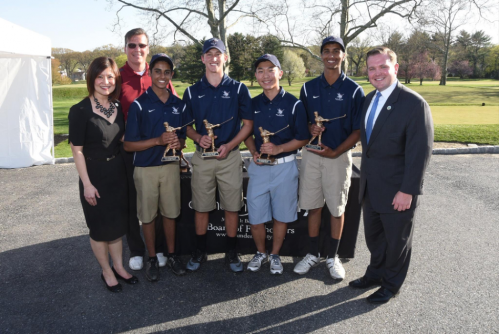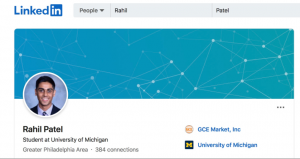Rahil Patel
I keep hearing over and over again to not believe everything I hear or see, especially on the Internet. My family, friends, and even mentors constantly tell me that not everything on the Internet is real, social media is a fake representation of people’s real lives, and to find the truth one must dig deeper than surface level information found on the Internet. But is it true that most of the information I find on the Internet is not credible? In this enlightening data identity assignment, I was left with some interesting takeaways about the differences between my true self and the person the Internet portrays me to be. There were definitely some things about me that are completely true and accurately depict who I am as a person, but the complete picture of who I am was not entirely depicted. You would not be able to find many aspects of who I am in real life by just searching my name on the Internet.
Contents
Results from a Simple Google Search
After a quick google search of my name, I knew that identifying the Internet’s depiction of me would be more difficult than I had initially thought. The main challenge with this process was that my last name is “Patel”. There are upwards of five million Patel’s in the world, as it is one of the most common last names for people of Indian origin. My first name, “Rahil”, is also a relatively common first name for people of Indian origin. As a result, I had a very difficult time identifying pieces of digital information that pertained to me instead of the many other Rahil Patel’s that existed in the world. In order to address this issue, I added a short keyword to the end of my name so that information that pertained to me would appear rather than information about a different Rahil Patel. After employing this strategy, I was able to attain better results. The three main categories of keywords that I tried were golf, Michigan, and social media. These are the three areas where I have the greatest digital footprint and the most information is available about me.
Golf
Throughout the past dozen years or so, golf has been an important part of my life. Ever since middle school, I have played competitively and taken the game very seriously. I have played on the Philadelphia Junior Tour in middle school and high school, competed in varsity golf in high school, and played for the University of Michigan Club golf team as an undergraduate.
When searching my name in google paired with the keyword golf, I noticed a disparity in the amount of information available between my three different competitive golf involvements. There was an abundance of information about my involvement with the Philadelphia Junior Tour and varsity high school golf team, but virtually no information about my involvement with the University of Michigan Club Golf Team. Overall, I was honestly surprised with how much information was available about myself in relation to golf. More specifically, there was information about all fifty or so tournaments I have ever competed in with the Philadelphia Junior Tour. From past scores to standings to awards, I was surprised that all of this information was published and available to anyone in the world. Similarly, there was an abundance of information available about me regarding my involvement with my high school varsity team. More specifically, there was information about team rosters, scores, standings, various articles, past tournaments, and awards all published on the Internet and available to anyone interested.
Although there was much information about my golf history as it relates to the Philadelphia Junior Tour and my high school varsity team, the Internet was missing a key piece: my involvement with the University of Michigan Club Golf Team. There was almost no information about me on this team other than the fact that I was on the roster. My guess for this is because the team was formed more for recreational purposes and meeting new people than hardcore competition. Either way, if someone were to search my name on the Internet as it pertains to golf, they would be able to see a lot of detailed information about my prior experiences in middle school and high school, but there would be a gap for college even though I was still involved with the sport.
Michigan
After searching my name with the keyword “Michigan” next to it, I was fairly surprised with the results, or lack thereof. As a student of the University of Michigan who has been in Ann Arbor for four years and involved in a multitude of extracurricular activities, there was a lack of information about my involvement. From my immersion in various clubs such as Alliance Consulting Group and Michigan Business Club, I was surprised by the lack of information available on the Internet. However, there was one major hit that did come up during this search, my LinkedIn profile. Although all of my individual involvements did not appear in the search, the appearance of my LinkedIn profile in the search results served as compensation. My profile summarized all of my academic and extracurricular involvements that were not openly portrayed on the Internet. People who search me on the Internet would actually learn a lot about me from reviewing my LinkedIn profile, which is intentional because I want recruiters and people in the professional domain to understand my background in order to make connections and advance my career. More specifically, there is information about my academic interests (major, minor, relevant coursework, and GPA), athletic involvement with golf, extracurricular involvement with on campus clubs, and professional experiences with past internships and jobs. Anyone with a LinkedIn account can access this relevant information about my past, but it does not paint the entire picture of who I am. People will not be able to learn about my personality, hobbies, and personal life outside of academics and professional experiences. This is exactly why companies interview candidates for a job rather than solely looking at resumes and cover letters. They want to learn more about each individual candidate’s personality and interests beyond what is written on paper. This same principle can be applied to my digital identity on the Internet.
Social Media
The last set of relevant keywords that I paired with my name was different social media companies such as Twitter, Facebook, and Instagram. Compared to the average person my age, I am much less active on social media. This was directly reflected in the results that appeared in my Google search. For Instagram and Twitter, both of my accounts are private, meaning that in order to view the content on my profile, you would have to follow my account. Since I only have about 500 followers on each account, the number of people who have access to my posts are very limited. Even if someone was following me, they would not be able to gain much insight as to who I am as a person simply because I do not post that often. On twitter specifically, I mainly just retweet content related to my favorite sports teams: the Michigan Wolverines, Philadelphia Eagles, and Philadelphia 76ers. Other than that, there is very little personal information available about me on social media. As a result, someone could find some information about me on social media, but the information will be very limited and will portray only a fraction of the person I am.
Self-Reflection
I now have more insight into answering the original question I posed regarding whether you should believe everything you see on the Internet. Essentially, all of the information that can be found online about me is true and accurate, but it only touches on surface level facts about my past experiences and background. There are major gaps of information about my life, especially when it comes to my personality and personal interests outside of the academic and professional environment. I am glad I had the opportunity to dig deeper into my digital footprint to understand the key similarities and differences between my real self and the person the Internet says I am.
The Bigger Picture
Diving deep into my digital footprint and online identity goes well beyond just me as there is a more important, overarching lesson to be learned. After critical self-reflection and reading the reflections of my peers regarding their online identities, I have learned that almost nobody is the same person the Internet portrays them to be as they truly are in real life. With social media platforms such as Facebook and Instagram or even professional media platforms such as LinkedIn, people often only post their highlights, which creates a deceptive portrayal of the life that they actually live. It is important to contextualize what you see on the Internet about other people. You must think about why a particular piece of information was posted on the Internet and by whom. As the digital world continues to rapidly grow, it will become increasingly important to analyze and contextualize the digital information we come across in order to draw meaningful insights rather than surface level observations.

